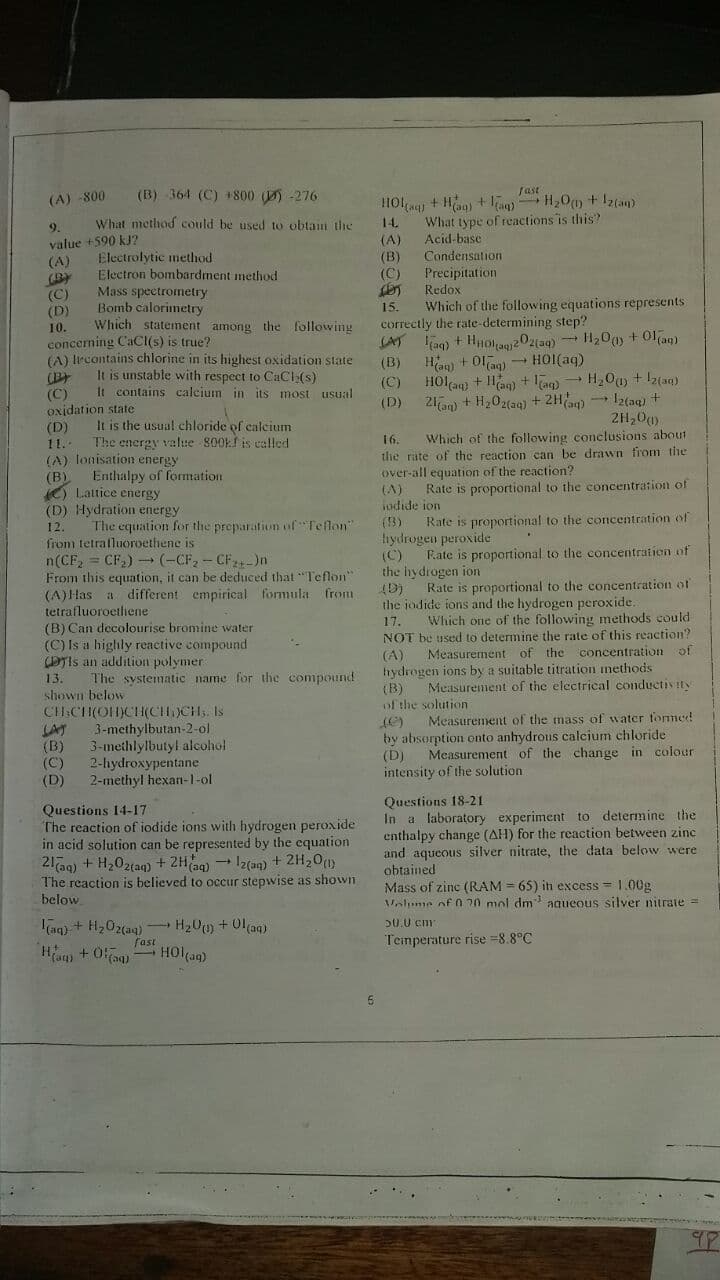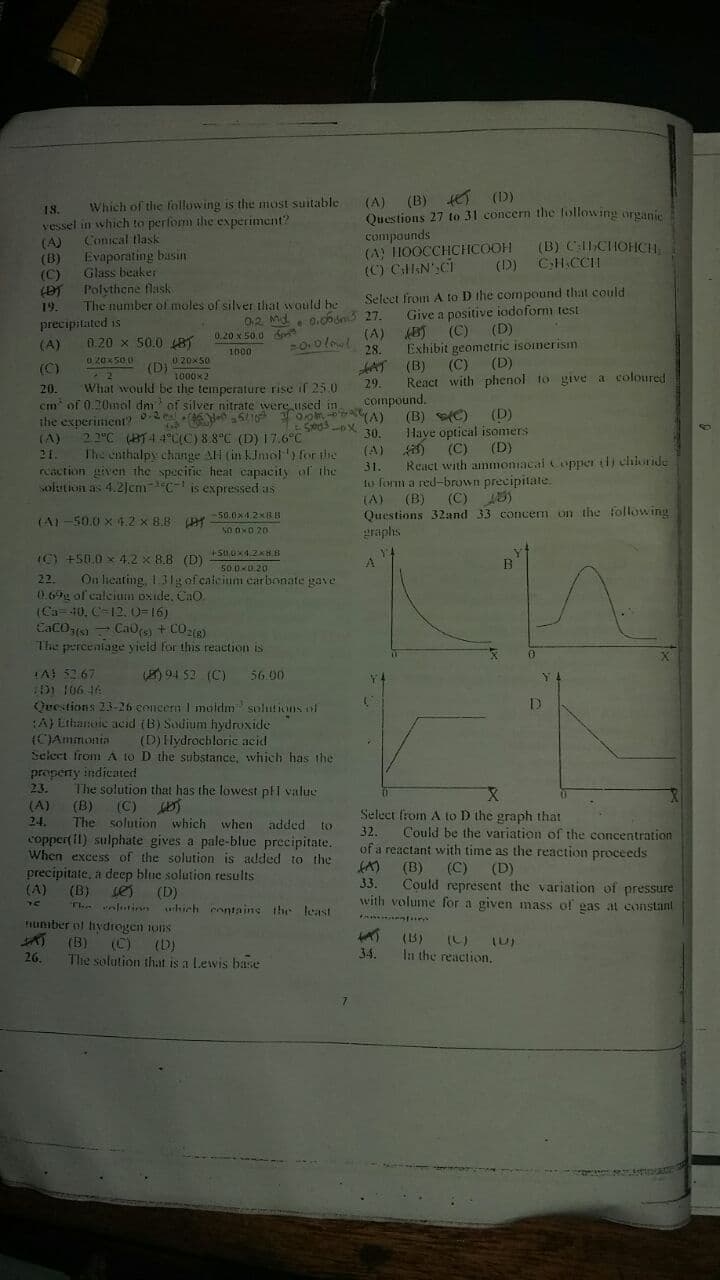18. Which of the following is the most suitable vessel in which to perfom the experiment? (A) Conical flask (B) Evaporating basin (C) Glass beaker (D Polythene flask 19. The number of moles of silver that would be Selce precipitated is (A) 0.20 x S0.0 48 (A) Ques comp (C) C 02 Md. 0.c63 27. (A) 28. 0.20 x 50.0 1000 0.20x50 0 (C) 0.20x50 (D) AT 29. 1000x2 20. What wvould be the temperature rise if 25.0 cm of 0.20mol dnm of silver nitrate were used in comp- the experitient?0. 5/ (A) 22°C (BT 4 4C(C) 8.8°C (D) 17.6°C The enthalpy change All (in kJnmol 'y for the rcaction given the specitic heat capacity of the solution as 4.2JcmC-is expressed as 30. 21. (A) 31. lo fon (A) (AI-50.0 x 4.2 x 8.8 T 50.0x4.2x8B So ONO 20 Ques eraph: (C) +50.0 x 4.2 x 8.8 (D) 14 500-0.20 ueL carhonate 22 timg
18. Which of the following is the most suitable vessel in which to perfom the experiment? (A) Conical flask (B) Evaporating basin (C) Glass beaker (D Polythene flask 19. The number of moles of silver that would be Selce precipitated is (A) 0.20 x S0.0 48 (A) Ques comp (C) C 02 Md. 0.c63 27. (A) 28. 0.20 x 50.0 1000 0.20x50 0 (C) 0.20x50 (D) AT 29. 1000x2 20. What wvould be the temperature rise if 25.0 cm of 0.20mol dnm of silver nitrate were used in comp- the experitient?0. 5/ (A) 22°C (BT 4 4C(C) 8.8°C (D) 17.6°C The enthalpy change All (in kJnmol 'y for the rcaction given the specitic heat capacity of the solution as 4.2JcmC-is expressed as 30. 21. (A) 31. lo fon (A) (AI-50.0 x 4.2 x 8.8 T 50.0x4.2x8B So ONO 20 Ques eraph: (C) +50.0 x 4.2 x 8.8 (D) 14 500-0.20 ueL carhonate 22 timg
Principles of Instrumental Analysis
7th Edition
ISBN:9781305577213
Author:Douglas A. Skoog, F. James Holler, Stanley R. Crouch
Publisher:Douglas A. Skoog, F. James Holler, Stanley R. Crouch
Chapter19: Nuclear Magnetic Resonance Spectroscopy
Section: Chapter Questions
Problem 19.3QAP
Related questions
Question
Answer Q18, 19, 20, 21

Transcribed Image Text:(B) 364 (C) + 800 ) -276
fast
(A) -800
HOl + Hn) + )
What type of reactions is this?
Acid-base
9.
What method could be used to obtam the
14.
value +590 kJ?
(A)
(BY
(C)
(D)
(A)
Electrolytic method
Electron bombardment method
Mass spectrometry
Bomb calorimetry
Which statenent among the following
Condensation
Precipitation
Redox
Which of the following equations represents
(B)
(C)
15.
correctly the rate-determining step?
(AT
10.
concerning CaCI(s) is true?
(A) lrcontains chlorine in its highest oxidation state
(B
(C)
oxjdation state
(D)
(B)
Hag) + Ola) - HOI(aq)
It is unstable with respect to CaCI (s)
It contains calcium in its most usual
(C)
HOlaq) + Han) + ag) - H,0u) + Iz(aq)
(D)
21an) + H202(aq) + 2Ha) Iz(aq) +
2H,00)
It is the usual chloride of calcium
The energy value 800k is called
16.
Which of the following conclusions about
11.
(A) lonisation energy
(B)
O Lattice energy
(D) Hydration energy
the rate of the reaction can be drawn from the
over-all equation of the reaction?
Enthalpy of formation
Rate is proportional to the concentration of
(A)
iudide ion
The equation for the preparation of Teflon
(13)
Rate is proportional to the concentration of
12.
from tetrafluoroethene is
n(CF, = CF2) - (-CF, - CF-)n
From this equation, it can be deduced that "Teflon"
(A)Has a different empirical formula from
tetrafluoroetfiene
(B) Can decolourise bromine water
(C) Is a highly reactive compound
DTIS an addition polymer
tıydrogen peroxide
(C)
the hydrogen ion
(D)
the jodide ions and the hydrogen peroxide.
Fate is proportional to the concentration of
Rate is proportional to the concentration of
Which one of the following methods could
NOT be used to determine the rate of this reaction?
Measurement of the concentration of
17.
(A)
hydrogen ions by a suitable titration methods
(B)
of the solution
13.
The systematic name for the compound
Measurement of the electrical conductivity
shown below
CHICH(OH)CH(CH)CH Is
LAT
(B)
(C)
(D)
Measurement of the mass of water fomed
3-methylbutan-2-ol
3-methlylbutyl alcohol
2-hydroxypentane
2-methyl hexan-1-ol
(C)
by absorption onto anhydrous calcium chloride
(D)
intensity of the solution
Measurement of the change in colour
Questions 14-17
The reaction of iodide ions with hydrogen peroxide
in acid solution can be represented by the equation
21a9) + H202{aq) + 2Hag) Iz(an) + 2H20(1)
The reaction is believed to occur stepwise as shown
below
Questions 18-21
In a laboratory experiment to determine the
enthalpy change (AH) for the reaction between zinc
and aqueous silver nitrate, the data below were
obtained
Mass of zine (RAM = 65) in excess = 1.00g
Valume of 0 20 mol dm aqueous silver nitrate =
aq) + H,02(a4) H20 +01(aq)
fast
HOl(aq)
20.0 cm
Teinperature rise =8.8°C
Ham + 0)

Transcribed Image Text:(A)
(B) (D)
Which of the following is the most suitable
Questions 27 to 31 concern the lollowing organic
compounds
(A) THOOCCHCHCOOH
(C) CllEN',CI
18.
vessel in which to perfom the experiment?
(A)
(B)
(C)
Conical tlask
Evaporating basin
Glass beaker
Polythene flask
(B) CCHOHCH
CH.CCH
(D)
Seleet from A to D the compound that could
Give a positive iodoform test
19.
The number of moles of silver that would he
0.c6dn3 27.
(A)
00ll
precipitated is
02 Md
(C)
(D)
0.20 x 50.0 S
1000
(A)
0.20 x 50.0 18
28.
Exhibit geometric isomerism
020x500
020x50
(D)
1000x2
(C)
(D)
(B)
React with phenol to give a coloured
(C)
AT
29.
What would be the temperature rise if 25.0
cm of 0.20mol dm of silver nitrate vere used in
20.
compound.
(D)
(B) C)
Haye optical isomers
(C)
React with ammoniacal Copper ti) chloride
lo form a red-brown precipitate.
(C) A)
the experiment? 2 e 6 S
30.
2 2°C (BT4 4C(C) 8.8°C (D) 17.6°C
The enthalpy change AlH (in kInol y for the
reaction given the specifie heat capacity of the
solution as 4.2JcmC- is expressed as
(A)
(A)
(D)
21.
31
(A) (B)
Questions 32and 33 concem on the following
graphs
50.0x4.2XRB
(A1-50.0 x 4.2 x 8.8
SO OND 20
IC) +50.0 x 4,2 x 8.8 (D)
50.0-0.20
On licating, 131g of calcium carbonate gave
22.
0.69g of calcium bxide, CaO.
(Ca=40, C=12, O=16)
CaCOs) CaOs) + CO 8)
The percenlage yield for this reaction is
TA! 567
D1 106 46
Qrestions 23-26 concern I moldm solutions of
A) Lthanoie acid (B) Sodium hydroxide
(CJAmimonia
Select from A to D the substance, which has the
properny indicated
23.
94 52 (C)
56.00
(D)Hydrochloric acid
The solution that has the lowest pFl value
(C) )
The solution which when added to
coppert il) sulphate gives a pale-blue precipitate.
When excess of the solution is added to the
precipitate, a deep blue solution results
(D)
T. nlutire urhich contains the least
(A)
(B)
Select from A to D the graph that
Could be the variation of the concentration
of a reactant with time as the reaction proceeds
24.
32.
(B)
Could represent the variation of pressure
with volume for a given nass of gas at constant
(C)
(D)
(A)
(B)
ses
33.
Tuniber ol hydrogen ons
(B)
(C) (D)
The solution that is a Lewis base
(B)
26.
34.
In the reaction.
Expert Solution
This question has been solved!
Explore an expertly crafted, step-by-step solution for a thorough understanding of key concepts.
Step by step
Solved in 2 steps with 2 images

Knowledge Booster
Learn more about
Need a deep-dive on the concept behind this application? Look no further. Learn more about this topic, chemistry and related others by exploring similar questions and additional content below.Recommended textbooks for you

Principles of Instrumental Analysis
Chemistry
ISBN:
9781305577213
Author:
Douglas A. Skoog, F. James Holler, Stanley R. Crouch
Publisher:
Cengage Learning

Chemistry for Engineering Students
Chemistry
ISBN:
9781285199023
Author:
Lawrence S. Brown, Tom Holme
Publisher:
Cengage Learning

Principles of Instrumental Analysis
Chemistry
ISBN:
9781305577213
Author:
Douglas A. Skoog, F. James Holler, Stanley R. Crouch
Publisher:
Cengage Learning

Chemistry for Engineering Students
Chemistry
ISBN:
9781285199023
Author:
Lawrence S. Brown, Tom Holme
Publisher:
Cengage Learning